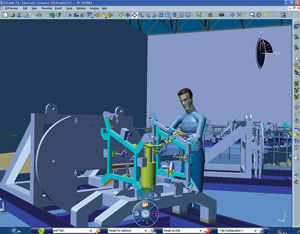Catia V6, Synchronous Technology and Experience
 I was digging around for something else, and found this. It is about two months old, and is speaking in reference to Catia V6.
I was digging around for something else, and found this. It is about two months old, and is speaking in reference to Catia V6.
V6 is a brand new kernel, one that has capabilities that Florack claims to be unrivalled in the industry, being able to resolve Geometry and Topology simultaneously and being able to open files from pretty much any existing CAD system and edit it natively. V6 is claimed to remove many of these painful limitations that the CAD industry has suffered long and hard from.
It comes from this MCAD mag article by Martyn Day. The first part of the article is incomprehensible CAD doublespeak, but one phrase from this quoted block stands out – “and edit it natively”. Who knows what they are actually saying, but what I”m hearing is that the new Catia kernel is also on this direct editing bandwagon.
 And of course the next question is why should SW continue to line the pockets of their competitors (UG/Solid Edge) by paying for the Parasolid kernel, when they could just integrate the Catia kernel? I think a lot of people have asked that question for a long time. The Parasolid kernel seems to be very effective, but Synchronous Technology is separate from Parasolid, and the Spaceclaim style direct modeling functionality sounds to be built into the Catia V6 kernel.
And of course the next question is why should SW continue to line the pockets of their competitors (UG/Solid Edge) by paying for the Parasolid kernel, when they could just integrate the Catia kernel? I think a lot of people have asked that question for a long time. The Parasolid kernel seems to be very effective, but Synchronous Technology is separate from Parasolid, and the Spaceclaim style direct modeling functionality sounds to be built into the Catia V6 kernel.
I think one of the stumbling blocks of the Spaceclaim/Synchronous Technology paradigm is going to turn out to be that it really only deals with analytical geometry – flat and cylindrical geometry. It doesn”t work on more generalized shapes required by NURBS. When they announce that, well, then I”ll be excited.
If we”re talking about Catia V6, we can”t just talk about direct editing speculation. There are other things as well that are important in V6.
 It might have been 5 years ago when we heard Bernard Charles say that CAD interoperability was going to come about by all software working across all hardware and OSes. At the time it was seen as a dodge for getting around the notorious SW/Catia lack of interoperability. SolidWorks had a viewer version that ran on Java, but it was unusably slow. It sounds like part of the vision of V6 on a larger scale is to start to deliver on the interoperability using more modern tools. One way of overcoming interoperability problems is to just ignore the proprietary feature history, and use direct editing. It also solves the marketing dilemma of “why can”t SW and Catia share files?” and another huge one “why can”t SW07 read SW08 files?” One aspect of this direct modeling concept that people aren”t jumping up and down about is that the whole version compatibility issue simply goes away. If you have direct editing software, you are compatible with all versions of other software programs.\n\nSaaS, software as a service, the ominous threat of delivering applications primarily across the web instead of having them installed locally, seems to play an obvious role in all of this. Even SW people have been making sure that those listening are hearing the SaaS message again and again. Do you really believe it? Do you really want to?
It might have been 5 years ago when we heard Bernard Charles say that CAD interoperability was going to come about by all software working across all hardware and OSes. At the time it was seen as a dodge for getting around the notorious SW/Catia lack of interoperability. SolidWorks had a viewer version that ran on Java, but it was unusably slow. It sounds like part of the vision of V6 on a larger scale is to start to deliver on the interoperability using more modern tools. One way of overcoming interoperability problems is to just ignore the proprietary feature history, and use direct editing. It also solves the marketing dilemma of “why can”t SW and Catia share files?” and another huge one “why can”t SW07 read SW08 files?” One aspect of this direct modeling concept that people aren”t jumping up and down about is that the whole version compatibility issue simply goes away. If you have direct editing software, you are compatible with all versions of other software programs.\n\nSaaS, software as a service, the ominous threat of delivering applications primarily across the web instead of having them installed locally, seems to play an obvious role in all of this. Even SW people have been making sure that those listening are hearing the SaaS message again and again. Do you really believe it? Do you really want to?
 Anyway, the SaaS dream is being combined with the old virtual reality dream, and the word “experience” is being abused to the point I expect it to file suit. “If you build it, they will come”. Does this really apply to a “Second Life” sort of application for manufacturers?
Anyway, the SaaS dream is being combined with the old virtual reality dream, and the word “experience” is being abused to the point I expect it to file suit. “If you build it, they will come”. Does this really apply to a “Second Life” sort of application for manufacturers?
 SolidWorks Island on Second Life seems to be one of those marketing feelers to see if this was a great idea that no one ever recognized. SolidWorks Island is a lonely place where you can ride surfboards on the sand and watch videos of the real world while you sit by yourself in a virtual world. Anyway, not to say its a bad idea, maybe just that people aren”t quite ready for it yet.
SolidWorks Island on Second Life seems to be one of those marketing feelers to see if this was a great idea that no one ever recognized. SolidWorks Island is a lonely place where you can ride surfboards on the sand and watch videos of the real world while you sit by yourself in a virtual world. Anyway, not to say its a bad idea, maybe just that people aren”t quite ready for it yet.
I can see where the immersive “experience” might work out for things like planes, trains and automobiles, Catia”s forte, but probably not so much for the ventillation system, or a potato peeling machine. By now we”ve all seen the DS ad where people in the real world interact directly with virtual people and virtual stuff. Maybe this kind of thing is 50 years off. Maybe for some industries much less. It all seems to fall into the “2D is going to disappear” category of CAD salesmen”s wet dreams.
So, editability with direct editing is great, banishing the version problems forever will be great, but direct editing has a lot of questions to answer. It is certainly not going to replace parametrics, but is it really of much benefit when they are used together (a la Synchronous Technology), or will it be used separately, and side by side (a la Spaceclaim)? And who is ready for that really immersive experience?
